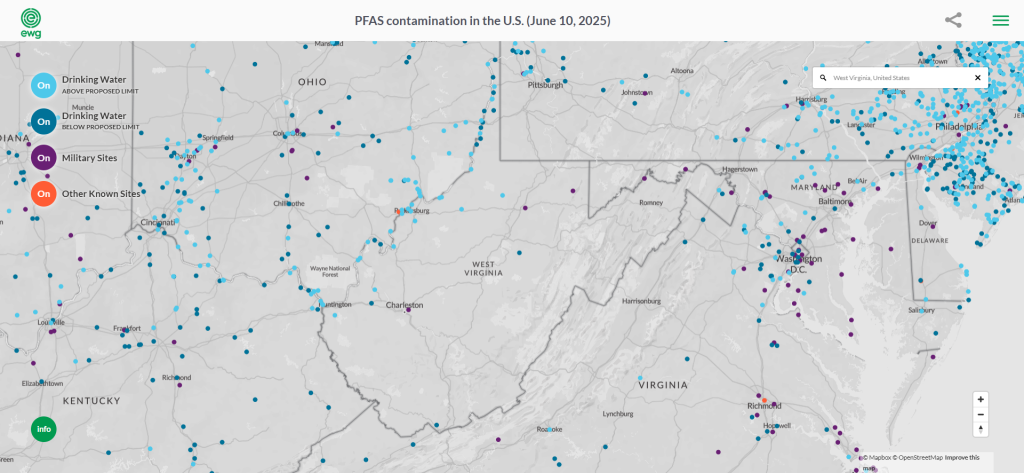- Home
- Personal Injury
- PFAS Lawsuit
- PFAS Contamination Map
- PFAS in West Virginia
PFAS in West Virginia
- Last updated: July 16, 2025
-
Contributor: nicky

I have followed the evolving concerns about PFAS West Virginia contamination and noticed how it continues to shape discussions about public health and environmental safety. PFAS (per- and polyfluoroalkyl substances) are synthetic chemicals found in several communities across West Virginia, prompting worries about long-term health effects. According to a 2019 exposure assessment by the Centers for Disease Control and Prevention (CDC) and the Agency for Toxic Substances and Disease Registry (ATSDR), elevated PFAS levels were detected in residents near Shepherd Field Air National Guard Base in Berkeley County, highlighting the scope of contamination and its potential risks (ATSDR, 2022).
My aim here is to present what PFAS are, why they matter, and how West Virginia has responded thus far. I will also explore health risks, discuss which communities have been affected, and address options for testing your water or soil. If you suspect PFAS exposure and wonder whether you qualify for a legal claim in West Virginia, my hope is to guide you toward the right information so that you can make informed decisions.
What are PFAS and why are they dangerous?
PFAS are a group of thousands of man-made substances prized for their resistance to heat, water, and oil. They have been used in a variety of products, such as firefighting foam, nonstick cookware, stain-resistant fabrics, and food packaging. While this durability makes PFAS valuable for specific industrial applications, it also causes them to persist in the environment and accumulate in the human body.
Researchers have linked certain PFAS compounds—including PFOA, PFOS, and PFHxS—to a range of adverse health effects. These chemicals can remain in blood for years, meaning past exposures might still show up in lab tests. Studies have suggested that exposure to elevated PFAS levels may cause kidney cancer, testicular cancer, thyroid issues, and other conditions (CDC, 2024). In West Virginia, the presence of PFAS in drinking water and soil has raised the stakes for thousands of residents who might be inadvertently ingesting these contaminants.
Check here if you might be eligible for a PFAS lawsuit.
Where are PFAS found in West Virginia?
In my review of state monitoring programs, PFAS have been detected in both urban and rural areas of West Virginia. Certain regions—particularly those near industrial facilities, landfill sites, or military bases—have shown higher PFAS measurements. Recent sampling efforts by the West Virginia Department of Environmental Protection (WVDEP) indicate that private wells, surface waters, and municipal supplies can be impacted. The largest reported exposures so far include Martinsburg, where a shutdown of Big Springs Well in 2016 stemmed from PFAS contamination originating at Shepherd Field Air National Guard Base.
Additionally, some northern counties such as Doddridge, Marshall, Ritchie, Tyler, and Wetzel have seen elevated PFAS levels in water wells near oil and gas operations. According to published data, about 60% of the tested wells in these counties contained detectable PFAS concentrations, with four wells exceeding proposed federal limits (ATSDR, 2022). Overall, PFAS in West Virginia remain a widespread concern, especially for those who rely on untreated groundwater.
PFAS in West Virginia’s drinking water
For many residents, the greatest worry about PFAS revolves around drinking water supplies. PFAS are often water-soluble, making municipal and private wells a crucial point of exposure. Despite ongoing treatment improvements, the long half-life of these chemicals can mean that past contamination continues to affect local communities.
Contaminated cities and counties
Martinsburg, located in Berkeley County, has garnered significant attention. In 2016, city officials shut down withdrawals from the Big Springs Well after PFAS were detected at levels exceeding federal health advisories. Although a treatment system was installed and the well came back online in 2017, a 2019 assessment found that residents still had elevated PFHxS blood levels—2.5 times higher than the national average (CDC, ATSDR).
In other parts of the state, including northern counties with dense oil and gas activity, surface water concentrations of PFAS have averaged four times that of groundwater, potentially putting livestock and agriculture at risk. The U.S. Environmental Protection Agency (EPA) has proposed regulating PFOA and PFOS at a maximum contaminant level (MCL) of 4 parts per trillion, meaning many West Virginia water utilities may need expanded treatment systems once these regulations take effect.
West Virginia Department of Environmental Protection (WVDEP) testing
The WVDEP, aided by federal grants, continues to sample public and private water sources statewide. Through the PFAS Protection Act (HB 3189), signed into law in 2023, the agency is empowered to identify, monitor, and address PFAS sources more systematically. According to the law, public water systems must evaluate treatment methods and funding options to reduce PFAS levels if they exceed regulatory standards.
The WVDEP has initiated finished water sampling at over 100 sites where PFAS were previously detected in raw water.
A new working group, involving both WVDEP and the West Virginia Department of Health and Human Resources (DHHR), is exploring how to eliminate or minimize PFAS in finished water.
Federal funding of around USD 18.9 million will be allocated over two years to bolster PFAS testing and support system upgrades.
Legacy pollution from manufacturing facilities
I have also looked into historical pollution from manufacturing operations that used PFAS for industrial processes, such as in chemical plants or textile facilities. While the known sites are primarily concentrated near the Ohio River Valley border, emissions can travel far downstream or into groundwater. By implementing additional testing programs, state and federal agencies hope to pinpoint where older PFAS disposal practices have placed communities at risk.
PFAS in West Virginia’s soil and agriculture
When I examined how PFAS could enter the broader ecosystem, it became clear that soil contamination can be a significant factor. PFAS from firefighting foams or industrial runoffs can infiltrate soil, affecting crops and livestock. Areas of higher elevation (“upland recharge zones”), as described in local studies, appear more vulnerable due to limited hydrodynamic dispersion. This means agricultural wells in these upland areas might be drawing water from portions of the aquifer more prone to contamination.
Although West Virginia has not reported widespread PFAS levels that exceed federal guidelines for produce or livestock, research continues on how PFAS behave in farmland runoff. As PFAS have been detected in surface water across several counties, there is ongoing concern that farmland near contaminated streams could see increasing PFAS infiltration over time.
Health effects of PFAS exposure
PFAS compounds can accumulate in human blood, organs, and tissues. According to the CDC, frequent or long-term exposure may lead to various health problems:
Higher cholesterol levels or liver enzyme levels
Immune system suppression, affecting vaccine response
Hormonal disruptions in the thyroid
Potential developmental defects in fetuses or infants
Researchers caution that certain groups—like pregnant women, infants, and individuals with weakened immune systems—may be more vulnerable. Because PFAS are slow to leave the body, they can build up over years and continue to affect health even after the original source is mitigated.
PFAS-linked diseases in West Virginia
Much of the state’s attention has focused on specific diseases associated with PFAS. While ongoing research continues to gather evidence, kidney cancer, testicular cancer, thyroid disease, and liver damage remain top concerns. In West Virginia, some communities have already noted higher-than-expected rates of certain cancers and health outcomes.
Kidney cancer
Kidney cancer has drawn particular concern among those monitoring PFAS West Virginia contamination. The CDC issued a health alert in January 2024, emphasizing that exposure to PFAS may contribute to an increased risk of renal cell carcinoma, commonly known as kidney cancer (CDC, 2024). This aligns with national studies pointing to a correlation between elevated PFOA levels and higher kidney cancer incidence.
Testicular cancer
Another troubling link is testicular cancer. Data show that younger men, ages 15 to 44, face higher rates of testicular cancer in certain areas with PFAS contamination. Although not every case can be directly attributed to PFAS, ongoing research is assessing whether historically high PFAS discharges, such as those from firefighting foam used at military sites, correlate with the observed increase. Early detection and regular screening are vital for reducing the risk of severe outcomes.
Thyroid disease
Scientists have long examined how PFAS disrupt hormonal pathways. These substances can interfere with the thyroid gland’s ability to regulate metabolism. In West Virginia, local sampling results have suggested that individuals with higher PFAS levels might be more prone to thyroid irregularities. According to some studies, PFAS exposure could make the thyroid overactive or underactive, with symptoms like unexplained fatigue, weight changes, or swelling in the neck area.
Liver damage and cholesterol changes
Elevated PFAS levels can affect how the body produces and processes cholesterol. I learned that PFAS exposure may result in elevated LDL (“bad”) cholesterol. Disrupting normal liver functions also strains the body’s metabolism, sometimes spurring inflammation that can lead to more extensive issues. Although definitive proof is still under study, the potential correlation should not be ignored, especially for individuals already at higher risk of heart or liver disease.
How West Virginia is responding to the PFAS crisis
West Virginia authorities have rolled out several initiatives to better detect and control PFAS levels. From robust sampling programs to major legislative efforts, the state aims to reduce exposure risk for residents while ensuring that public health guidelines keep pace with evolving scientific consensus.
WVDEP monitoring and investigations
One key move was the signing of the PFAS Protection Act (HB 3189). This law instructs the WVDEP to identify point sources, develop action plans, and demand thorough reporting from industries that release PFAS. Ongoing monitoring focuses on high-risk sites such as industrial plants, airports, and firefighting training centers known to use PFAS-based foams.
In March 2023, a multi-agency working group formed to evaluate treatment processes and examine how to remove PFAS from finished water at 27 public water systems.
The WVDEP, in coordination with DHHR, launched sampling at 100 additional sites with prior PFAS detections in raw water.
Public advisories and health risk guidelines
Health officials issue advisories when PFAS contamination exceeds thresholds that might pose a risk to human health. You can find up-to-date guidance on the West Virginia DHHR website, which details testing frequency, water quality parameters, and best practices for residents who suspect their private wells may be compromised. Some public water systems also provide annual water quality reports, which indicate whether PFAS were detected and at what levels.
EPA assistance and federal grants
Federal agencies increasingly support West Virginia’s efforts. The EPA’s proposed rule on PFAS sets a maximum contaminant level of 4 parts per trillion for PFOA and PFOS, pushing states nationwide to comply with stricter standards. While this regulation is still under review, investments are already flowing:
About USD 18.9 million in federal funds over two years focuses on testing, research, and infrastructure to address PFAS in drinking water.
Public water systems exceeding future EPA limits will likely receive financial support to implement advanced treatments, such as granular activated carbon or reverse osmosis filtration systems, ensuring safe supplies for communities.
Can you test your water or soil for PFAS in West Virginia?
If you rely on a private well or suspect your property might be contaminated, testing can give you clarity. Several certified laboratories can analyze water or soil samples for various PFAS compounds. I always tell people to:
Contact your local health department for initial guidance on state-approved labs.
Follow recommended sampling procedures to avoid false positives or cross-contamination.
Compare your test results against federal and state advisory levels.
Consult environmental professionals if results exceed safe limits.
Public water systems often have their own routine testing protocols, and many publish annual Water Quality Reports. If you are part of a municipal supply, check these documents or contact local officials to see how PFAS levels are being managed.
Do you qualify for a PFAS lawsuit in West Virginia?
If you or a loved one has experienced adverse health effects that might be traced to PFAS contamination, you could be eligible for legal action. Lawsuits might target manufacturers responsible for releasing PFAS into the environment or facilities that neglected to warn communities about potential hazards. Although each claim varies, I have seen:
People seeking compensation for medical bills, lost wages, or reduced property value.
Plaintiffs alleging harm from contaminated water supplies or firefighting foam.
Lawsuits against large chemical companies and local entities that failed to prevent or control PFAS discharges.
To explore your legal options, you can contact an experienced PFAS attorney or turn to platforms designed to help individuals navigate this process.
Why choose legal claim assistant
I have always believed that taking legal action is not just about compensation, but about accountability and prevention. At Legal Claim Assistant, you can find resources for:
Free initial case reviews.
Attorney matching to law firms specializing in complex PFAS litigation.
Information on how to gather proof of exposure, including medical records and water test results.
If you need even more insight into how legal claims can address industry-wide negligence, you might also find their DuPont Lawsuit page a useful reference. Whether test results show high PFAS levels or you have a confirmed diagnosis linked to PFAS exposure, Legal Claim Assistant helps streamline the entire process so you can focus on your health.
Frequently asked questions (FAQ)
I often hear recurring questions about PFAS in West Virginia, how they spread, and what steps residents can take. Below are some of the most common queries.
PFAS contamination has been documented around Shepherd Field Air National Guard Base in Berkeley County, in northern counties with oil and gas operations, and near older manufacturing facilities. Martinsburg is among the most high-profile cases, where the Big Springs Well was offline for treatment in 2016 because of PFOS contamination.
Yes. You can contact certified laboratories recommended by the WVDEP or your local health department. They can provide sampling instructions and ensure accurate test results. Make sure you follow all suggestions about container sterilization and sample handling to avoid unintentionally contaminating the sample.
The PFAS Protection Act (HB 3189) empowers the WVDEP to detect and mitigate PFAS sources by requiring more stringent reporting and water treatment protocols. Additional federal funding supports the replacement or enhancement of filtration systems, especially in communities where contamination levels exceed the EPA’s proposed 4 parts per trillion limit for PFOA and PFOS.
While PFAS can enter soil and water, West Virginia has not reported large-scale contamination in agricultural products. However, testing continues, particularly where PFAS levels in groundwater or surface water appear elevated. Farmers and consumers are encouraged to stay updated on results from ongoing WVDEP and DHHR monitoring programs.
Extensive studies have connected PFAS exposure to kidney cancer, testicular cancer, thyroid disease, high cholesterol, and possible immune system disruptions. The evidence continues to grow, with more data emerging on how PFAS behave in the human body over time.
You may be able to file a lawsuit if you can demonstrate that PFAS from a specific source caused or contributed to your illness or property harm. Each situation is different, so the best approach is to consult a specialized PFAS attorney. Resources like Legal Claim Assistant can help by connecting you to legal experts for a free case review.
Whether you are testing your well or worrying about possible exposures, you do not have to face PFAS contamination alone. By staying informed and seeking professional guidance, you can protect yourself and your family while supporting broader efforts to reduce contamination throughout West Virginia. If you want to learn how PFAS contamination compares in other regions, you can explore resources like in Virginia and Georgia.
Overview PFAS contamination in the USA
Here you van find the PFAS watercontamination map of the United States. Find, state by state, where water contamination has occurred due to PFAS exposure.
- PFAS in Alabama
- PFAS in Alaska
- PFAS in Arizona
- PFAS in Arkansas
- PFAS in California
- PFAS in Colorado
- PFAS in Connecticut
- PFAS in Delaware
- PFAS in Florida
- PFAS in Georgia
- PFAS in Hawaii
- PFAS in Idaho
- PFAS in Illinois
- PFAS in Indiana
- PFAS in Iowa
- PFAS in Kansas
- PFAS in Kentucky
- PFAS in Louisiana
- PFAS in Maine
- PFAS in Maryland
- PFAS in Massachusetts
- PFAS in Michigan
- PFAS in Minnesota
- PFAS in Mississippi
- PFAS in Missouri
- PFAS in Montana
- PFAS in Nebraska
- PFAS in Nevada
- PFAS in New Hampshire
- PFAS in New Jersey
- PFAS in New Mexico
- PFAS in New York
- PFAS in North Carolina
- PFAS in North Dakota
- PFAS in Ohio
- PFAS in Oklahoma
- PFAS in Oregon
- PFAS in Pennsylvania
- PFAS in Rhode Island
- PFAS in South Carolina
- PFAS in South Dakota
- PFAS in Tennessee
- PFAS in Texas
- PFAS in Utah
- PFAS in Vermont
- PFAS in Virginia
- PFAS in Washington
- PFAS in West Virginia
- PFAS in Wisconsin
- PFAS in Wyoming
Related Article

What Philips CPAP Machines Are Recalled and Why

